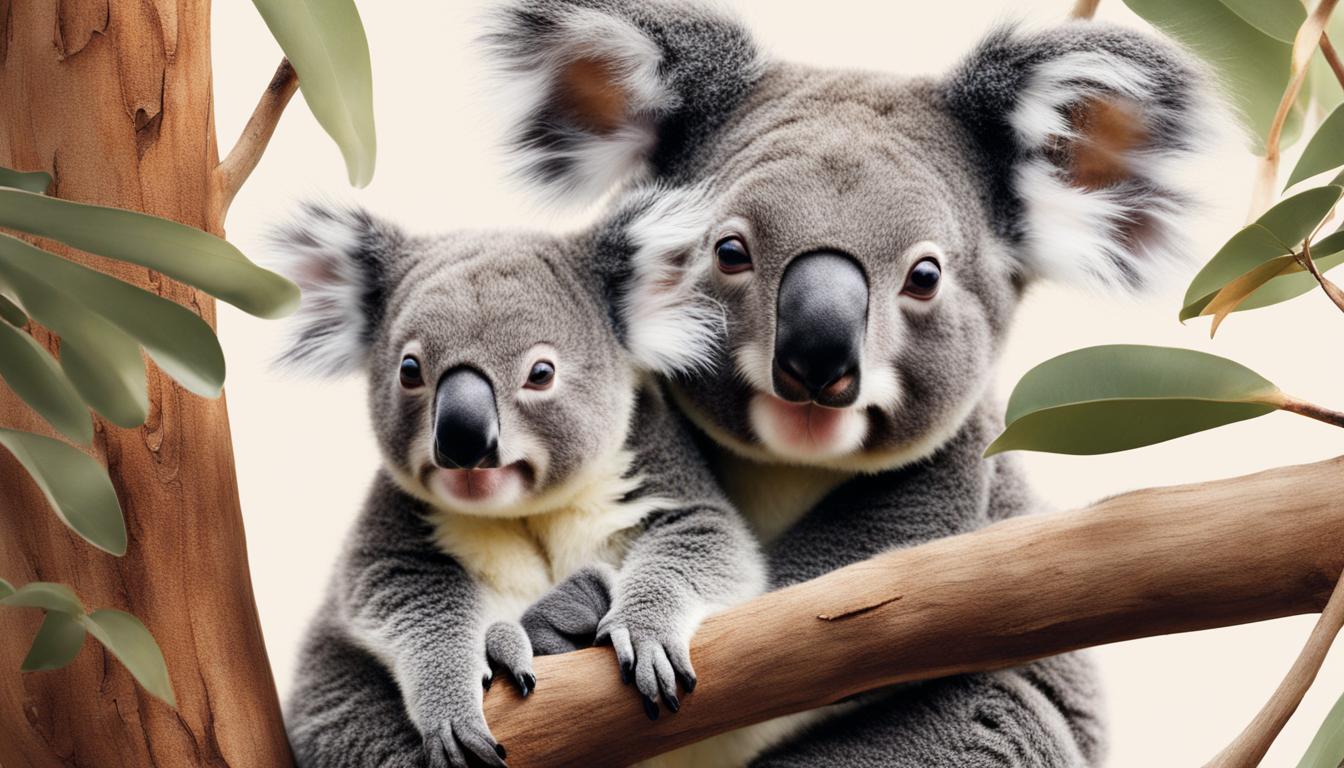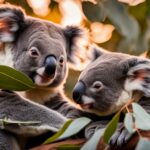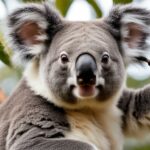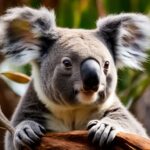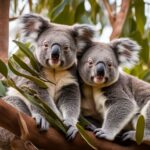Welcome to our article all about baby koalas! If you’re a fan of these adorable creatures, you’re in for a treat. In this section, we’ll explore how baby koalas, also known as joeys, develop and grow into the cute koalas we all love. We’ll cover everything from their unique birth to their diet and growth milestones. And of course, we’ll include plenty of baby koala pics to melt your heart!
So, get ready to learn fascinating facts about these furry little bundles of joy. By the end of this article, you’ll have a deeper understanding of the incredible journey that baby koalas go through and the importance of their care and habitat. Let’s dive in!
The life cycle of a baby koala
Baby koalas, known as joeys, go through a fascinating life cycle as they grow and develop. From their birth as tiny, hairless creatures to their eventual independence, each stage of their journey is essential for their survival. Let’s explore the different phases in the life of a baby koala.
Once a baby koala is born, it immediately climbs its way from the birth canal to its mother’s pouch. Inside the pouch, the joey attaches itself to a milk teat, where it will stay for the first few months of its life, feeding on its mother’s milk. During this time, the joey undergoes rapid development, growing fur, eyes, and ears.
At around 5 to 6 months old, the joey starts to venture out of the pouch and explore its surroundings. It begins to feed on a special substance called ‘pap,’ which is derived from its mother’s droppings. The pap helps the joey transition to an adult diet of gum leaves, which become the primary food source for koalas. As the joey grows, it spends more time outside the pouch, gradually becoming more independent.
Between the ages of 1 and 2 years, the joey leaves its mother to establish its own territory. It will find an area with an ample supply of gum leaves and begin its adult life as a fully grown koala. This journey from a helpless joey to an independent adult showcases the remarkable life cycle of baby koalas.
Baby Koala Life Cycle:
| Stage | Description |
|---|---|
| Birth | The baby koala, known as a joey, is born tiny, hairless, and underdeveloped. |
| Pouch Life | The joey climbs into its mother’s pouch, attaches to a milk teat, and stays there for the first few months. It grows fur, eyes, and ears during this stage. |
| Pap Feeding | At around 5 to 6 months old, the joey starts to venture out of the pouch and feed on ‘pap,’ a special substance derived from its mother’s droppings. This helps it transition to an adult diet of gum leaves. |
| Independence | Between 1 and 2 years of age, the joey leaves its mother to establish its own territory and live as an independent adult koala. |
Parental Care and Breeding Patterns of Koalas
Parental care is a critical aspect of the koala life cycle. Female koalas typically start breeding at around 3 to 4 years of age and have one joey each year, although not all females breed annually. The breeding season, which runs from August to March, is a time of heightened activity for koalas. During this period, the mother koala provides extensive care to her joey, ensuring its survival and development.
The mother koala carries her joey in her pouch for the first few months of its life. Inside the pouch, the joey attaches itself to a milk teat and relies exclusively on the mother’s milk for nourishment. This crucial bonding period allows the joey to grow and develop its eyes, ears, and fur. As the joey grows older, it starts to venture out of the pouch, spending increasing amounts of time outside.
In some cases, if a female koala does not reproduce each year, the joey may stay with her longer. However, once the next season’s joey emerges from the pouch, the older joey leaves to find its own home range. This process typically takes place between 1 and 2 years of age, marking the transition to independence for the joey.
Parental care is a critical aspect of the koala life cycle, with mothers providing extensive care to ensure the survival and development of their joeys.
Overall, the parental care and breeding patterns of koalas highlight the incredible bond between mother and joey. It is essential for us to understand and appreciate these dynamics to support the conservation efforts of these iconic Australian animals.
The diet of baby koalas
Baby koalas have a specialized diet that plays a crucial role in their growth and development. For the first six to seven months of their lives, baby koalas rely solely on their mother’s milk for nourishment. This milk provides them with essential nutrients and antibodies to support their rapidly growing bodies.
In addition to milk, baby koalas also consume a unique substance known as ‘pap.’ This soft and runny substance is derived from their mother’s droppings and serves an important purpose. ‘Pap’ contains microorganisms that are necessary for the digestion of gum leaves, which become the primary food source for adult koalas.
As baby koalas grow and become more independent, they gradually transition to a diet consisting primarily of gum leaves. They learn this diet from their mother and begin experimenting with different leaves to find their preferred food sources. Finding the right habitat with an ample supply of gum leaves is essential for the survival and growth of baby koalas.

| Dietary Stage | Food Source |
|---|---|
| Newborn to 6-7 months | Mother’s milk |
| Transition period | ‘Pap’ (soft and runny substance derived from mother’s droppings) |
| Independence achieved | Gum leaves (primary food source) |
“The specialized diet of baby koalas, combining their mother’s milk and ‘pap,’ is essential for their growth and survival. As they transition to a diet of gum leaves, they learn from their mother and gradually become more independent in finding food sources. Protecting their habitat with an abundant supply of gum trees is crucial for ensuring the well-being of these adorable creatures.”
- Baby koalas rely on their mother’s milk for nourishment during the early stages of their lives.
- ‘Pap,’ a soft and runny substance derived from their mother’s droppings, provides essential microorganisms for digesting gum leaves.
- As they grow, baby koalas transition to a diet consisting primarily of gum leaves, learning from their mother and experimenting with different leaves.
- Finding the right habitat with sufficient gum trees is crucial for the survival and growth of baby koalas.
Growth and Development of Baby Koalas
Baby koalas undergo a remarkable journey of growth and development, transforming from tiny, hairless joeys into independent and fully-grown koalas. This process, spanning several months, is filled with pivotal milestones that shape the future of these adorable creatures.
From the moment of birth, baby koalas rely solely on their mother’s milk for nourishment. This nutrient-rich milk provides essential nutrients and antibodies, fueling the rapid growth and development of the joey. As they consume their mother’s milk, they begin to gain strength and grow at an astounding rate, gradually acquiring the features and characteristics that define a koala.
As the baby koala grows, it starts to venture outside of the pouch, exploring its surroundings under the watchful eye of its mother. This period marks a critical stage in their development, as they begin to sample different foods and learn the art of climbing and foraging. With each passing day, their coordination and dexterity improve, enabling them to navigate their environment with greater confidence.
Key Milestones in the Growth of Baby Koalas
| Milestone | Description |
|---|---|
| Birth | The joey is born blind, hairless, and tiny, weighing less than a gram. It crawls into its mother’s pouch to attach itself to a milk teat. |
| Pouch Life | The joey spends the first few months of its life inside the pouch, developing eyes, ears, and fur. It feeds exclusively on its mother’s milk, growing rapidly. |
| Pap Feeding | At around 5 to 6 months old, the joey starts to peek out of the pouch and begins consuming ‘pap’—a specialized substance derived from its mother’s droppings. |
| Independence | Between 1 and 2 years of age, the joey leaves its mother and establishes its own territory, fully grown and ready to face the challenges of life in the wild. |
By the time the baby koala leaves its mother’s care, it has undergone a complete transformation, from a vulnerable newborn to an independent and self-sufficient koala. The growth and development of baby koalas are a testament to the resilience and adaptability of these iconic Australian creatures.
The lifespan of koalas
Koalas have varying lifespans depending on their habitat. In good habitat, male koalas can live for about 10 years, while females may live a few years longer. However, koalas residing in suburban areas face more dangers and may only survive for a few weeks, months, or years due to threats such as cars and dogs. The average lifespan of a koala also depends on factors such as breeding frequency, habitat quality, and overall health.
Female koalas typically start breeding at around 3 to 4 years of age and can produce offspring every one to three years. The survival rate of dispersing sub-adult males, living near highways or housing estates, is much lower, with an average of two to three years.
| Koala | Lifespan (in good habitat) | Lifespan (in suburban areas) |
|---|---|---|
| Male | Approximately 10 years | Varies, depending on threats |
| Female | A few years longer than males | Varies, depending on threats |
It is important to note that koalas are vulnerable to habitat loss and human activities, which can significantly impact their lifespan. Conservation efforts, including the preservation of their natural habitat and the mitigation of threats, play a crucial role in ensuring the long-term survival of these iconic Australian animals.
Interesting Facts About Baby Koalas
When it comes to baby koalas, or joeys, there are plenty of interesting facts to discover. These adorable creatures are born blind, hairless, and resembling pink jellybeans. They rely on their strong forelimbs and sharp claws to navigate their way to their mother’s pouch, where they attach themselves to a milk teat and grow from the nourishment provided by their mother’s milk.
As baby koalas develop, they start to peek out of the pouch and feed on a specialized substance called ‘pap,’ which aids in their transition to a diet of gum leaves. This soft and runny form of their mother’s droppings provides essential microorganisms necessary for the digestion of gum leaves, which eventually become the primary food source for adult koalas.
In addition to their unique diet, baby koalas spend a significant amount of time sleeping. In fact, they can sleep for up to 20 hours a day! This extended sleep helps conserve energy and supports their rapid growth and development. Proper care and habitat preservation are crucial to ensure the survival of these adorable creatures.
| Interesting Facts About Baby Koalas |
|---|
| Baby koalas are born blind, hairless, and resemble pink jellybeans. |
| They rely on their strong forelimbs and sharp claws to navigate their way to their mother’s pouch. |
| They feed on a substance called ‘pap,’ which aids in their transition to a diet of gum leaves. |
| They can sleep for up to 20 hours a day. |
These remarkable creatures capture our hearts with their unique characteristics and behaviors. From their incredible journey of growth and development to their reliance on their mother’s care and a specialized diet, baby koalas are a true wonder of nature.
By understanding and appreciating these fascinating facts about baby koalas, we can work towards their conservation and ensure their growth and survival for generations to come.
Conclusion
Throughout their life cycle, baby koalas go through a remarkable journey of growth and development. From their birth as tiny, hairless joeys to their eventual independence, these adorable creatures rely on their mothers for nourishment and guidance.
It is important to understand that baby koalas require proper care and habitat preservation for their survival. Their unique diet, which starts with their mother’s milk and transitions to gum leaves, must be supported by an ample supply of suitable habitat.
By gaining knowledge about the behavior and life cycle of baby koalas, we can appreciate the wonders of nature and work towards their conservation. Let’s continue to raise awareness and protect these precious creatures for future generations to enjoy.
How Does a Koala’s Arboreal Lifestyle Affect the Development of Baby Koalas?
The koalas’ adaptation to arboreal lifestyle significantly influences the development of baby koalas. Living in trees teaches them to climb and grip, vital skills for survival. This lifestyle also exposes them to a specialized diet of eucalyptus leaves, shaping their feeding habits from an early age.
FAQ
How do baby koalas (joeys) develop and grow?
Baby koalas are born without fur and with underdeveloped eyes and ears. They make their way from the birth canal to their mother’s pouch on their own, climbing through the fur on her abdomen. Once inside the pouch, the joey attaches itself to a milk teat and stays there for the first few months of its life, drinking only mother’s milk. As it grows, the joey develops eyes, ears, and fur. At around 5 to 6 months old, the joey starts to peek out of the pouch and feed on a special food called ‘pap,’ which is a soft and runny form of the mother’s droppings. By 7 months, the joey leaves the pouch for longer periods of time and rides on its mother’s abdomen or back. It gradually gets used to a diet of gum leaves and eventually leaves its mother to set up its own home range between 1 and 2 years of age.
What is the life cycle of a baby koala?
The life cycle of a baby koala begins with its birth as a tiny, hairless joey. The joey makes its way to its mother’s pouch and attaches itself to a milk teat for nourishment. It stays in the pouch for the first few months, growing and developing eyes, ears, and fur. At around 5 to 6 months old, it starts to venture outside of the pouch and feed on ‘pap,’ which is a special substance derived from the mother’s droppings. As the joey grows, it spends more time outside the pouch and begins to eat gum leaves, gradually transitioning to an adult diet. Between 1 and 2 years of age, the joey leaves its mother and finds its own territory to live in.
What are the parental care and breeding patterns of koalas?
Female koalas start breeding at around 3 to 4 years of age and usually have one joey each year, although not all females breed every year. The breeding season runs from about August to March, during which koalas are very active. The mother koala provides extensive care to her joey, from carrying it in her pouch to nursing it with milk and eventually teaching it to eat gum leaves. The joey stays with its mother until the next season’s joey emerges from the pouch, at which point it leaves to find its own home range. In some cases, if a female does not reproduce each year, the joey may stay with her longer.
What is the diet of baby koalas?
Baby koalas have a specialized diet that consists mainly of their mother’s milk for the first six to seven months of their lives. During this time, they also consume a substance called ‘pap,’ which is a soft and runny form of their mother’s droppings. Pap provides essential microorganisms necessary for the digestion of gum leaves, which become the primary food source for adult koalas. As the joey grows and becomes more independent, it gradually transitions to a diet of gum leaves, learning from its mother and experimenting with different leaves. Finding the right habitat with an ample supply of gum leaves is crucial for the survival and growth of baby koalas.
How do baby koalas grow and develop?
Baby koalas go through a remarkable growth and development process. They start as tiny, hairless joeys and quickly grow inside their mother’s pouch, developing eyes, ears, and fur. As they venture outside of the pouch and start feeding on gum leaves, they continue to grow at a faster rate. The early stages of growth rely on their mother’s milk and the specialized food ‘pap,’ which aids in their digestion and provides essential nutrients. Over time, the baby koalas become more adventurous, exploring their surroundings and becoming more independent. By the time they leave their mother and establish their own territory between 1 and 2 years of age, they are fully grown and ready to navigate life in the wild.
What is the lifespan of koalas?
Koalas have varying lifespans depending on their habitat. In good habitat, male koalas can live for about 10 years, while females may live a few years longer. However, koalas residing in suburban areas face more dangers and may only survive for a few weeks, months, or years due to threats such as cars and dogs. The average lifespan of a koala also depends on factors such as breeding frequency, habitat quality, and overall health. Female koalas typically start breeding at around 3 to 4 years of age and can produce offspring every one to three years. The survival rate of dispersing sub-adult males, living near highways or housing estates, is much lower, with an average of two to three years.
What are some interesting facts about baby koalas?
Baby koalas, or joeys, are fascinating creatures. They are born blind, hairless, and tiny, resembling pink jellybeans. They rely on their well-developed senses of touch and smell, as well as their strong forelimbs and claws, to make their way to their mother’s pouch. Inside the pouch, they attach themselves to a milk teat and grow from the nourishment provided by their mother’s milk. As they develop, they start to peek out of the pouch and feed on a specialized substance called ‘pap,’ which aids in their transition to a diet of gum leaves. Baby koalas also spend a significant amount of time sleeping and require proper care and habitat to ensure their growth and survival.

